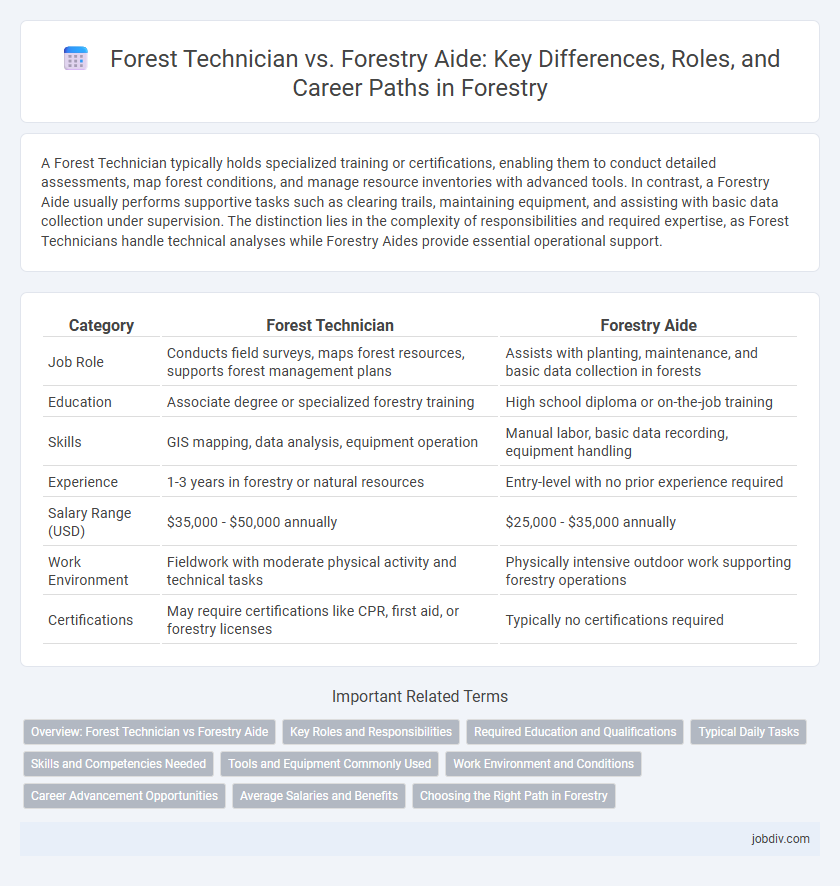A Forest Technician typically holds specialized training or certifications, enabling them to conduct detailed assessments, map forest conditions, and manage resource inventories with advanced tools. In contrast, a Forestry Aide usually performs supportive tasks such as clearing trails, maintaining equipment, and assisting with basic data collection under supervision. The distinction lies in the complexity of responsibilities and required expertise, as Forest Technicians handle technical analyses while Forestry Aides provide essential operational support.
Table of Comparison
| Category | Forest Technician | Forestry Aide |
|---|---|---|
| Job Role | Conducts field surveys, maps forest resources, supports forest management plans | Assists with planting, maintenance, and basic data collection in forests |
| Education | Associate degree or specialized forestry training | High school diploma or on-the-job training |
| Skills | GIS mapping, data analysis, equipment operation | Manual labor, basic data recording, equipment handling |
| Experience | 1-3 years in forestry or natural resources | Entry-level with no prior experience required |
| Salary Range (USD) | $35,000 - $50,000 annually | $25,000 - $35,000 annually |
| Work Environment | Fieldwork with moderate physical activity and technical tasks | Physically intensive outdoor work supporting forestry operations |
| Certifications | May require certifications like CPR, first aid, or forestry licenses | Typically no certifications required |
Overview: Forest Technician vs Forestry Aide
Forest Technicians are responsible for mapping, data collection, and implementing forest management plans using advanced tools like GPS and GIS, while Forestry Aides perform more general support tasks such as trail maintenance, planting, and basic data gathering. Technicians typically require formal education or certifications in forestry or natural resources, whereas Forestry Aides often receive on-the-job training with minimal formal qualifications. The distinct roles reflect varying levels of technical expertise and responsibility within forest management operations.
Key Roles and Responsibilities
Forest Technicians conduct detailed forest inventories, monitor ecosystem health, and implement conservation plans utilizing GPS and GIS technology for precise data collection. Forestry Aides support field operations by assisting in tree planting, maintaining trails, and gathering basic environmental data under the supervision of Forest Technicians. Both roles are essential for sustainable forest management, but Forest Technicians require specialized training and perform more complex analytical tasks compared to the operational support duties of Forestry Aides.
Required Education and Qualifications
Forest Technicians typically require an associate degree or diploma in forestry, environmental science, or natural resource management, combined with practical field experience. Forestry Aides often need a high school diploma or equivalent, with on-the-job training sufficing for basic forest maintenance tasks. Certifications in first aid, chainsaw operation, or equipment handling enhance qualifications for both roles.
Typical Daily Tasks
Forest Technicians conduct detailed field surveys, collect data on tree species, health, and growth, and assist in implementing forest management plans, while Forestry Aides primarily support manual tasks such as trail maintenance, fire prevention, and equipment handling. Forest Technicians utilize GPS and GIS technology for mapping and data analysis, whereas Forestry Aides focus on physically demanding duties like planting trees and clearing brush. Both roles contribute to sustainable forest management but differ in technical responsibilities and required expertise.
Skills and Competencies Needed
Forest Technicians require advanced skills in GIS mapping, data analysis, and equipment operation to conduct detailed forest assessments and support management plans. Forestry Aides typically possess fundamental competencies in basic forest maintenance, manual labor, and assistive tasks under supervision, emphasizing physical endurance and safety protocols. Both roles demand knowledge of environmental regulations and strong teamwork abilities, with Forest Technicians often needing additional certifications and technical training.
Tools and Equipment Commonly Used
Forest Technicians typically use advanced tools such as GIS software, GPS devices, dendrometers, and soil testing kits to conduct detailed environmental assessments and forest management planning. Forestry Aides often handle more manual equipment including chainsaws, hand tools, and measuring tapes to assist with basic forestry operations and maintenance tasks. Both roles require familiarity with safety gear and communication devices to ensure efficient and secure fieldwork.
Work Environment and Conditions
Forest Technicians typically work in diverse environments including remote forested areas, often enduring challenging weather and rugged terrain to conduct surveys and manage resources. Forestry Aides generally perform support tasks both outdoors and in office settings, facing less physically demanding conditions but still exposed to fluctuating weather elements. Both roles require adaptability to fieldwork environments, though Forest Technicians encounter more strenuous conditions related to technical data collection and site management.
Career Advancement Opportunities
Forest Technicians typically have stronger career advancement opportunities due to their specialized training in forest management, data collection, and equipment operation, enabling them to take on supervisory roles and technical specialist positions. Forestry Aides often start with entry-level tasks such as basic maintenance and assistance, with fewer pathways for advancement unless they pursue further education or certifications. Progression from Forestry Aide to Forest Technician is common by gaining experience and completing forestry-related training programs, which significantly broadens career prospects in natural resource management and conservation.
Average Salaries and Benefits
Forest Technicians typically earn an average salary of $45,000 to $60,000 annually, reflecting their specialized skills in forest management, data collection, and environmental assessment. Forestry Aides usually receive lower compensation, ranging from $30,000 to $40,000 per year, often due to their more entry-level responsibilities such as manual labor and basic maintenance tasks. Benefits for Forest Technicians commonly include health insurance, retirement plans, and paid leave, while Forestry Aides may have more limited benefits depending on the employer and experience level.
Choosing the Right Path in Forestry
Forest Technicians possess technical skills in mapping, data collection, and forest management software, making them ideal for roles involving detailed environmental assessments and resource planning. Forestry Aides typically handle physical tasks such as trail maintenance, planting, and basic data gathering, providing essential support in field operations and conservation efforts. Choosing between the two depends on one's interest in hands-on labor versus technical analysis, as well as career goals in forestry management and ecological research.
Forest Technician vs Forestry Aide Infographic

 jobdiv.com
jobdiv.com